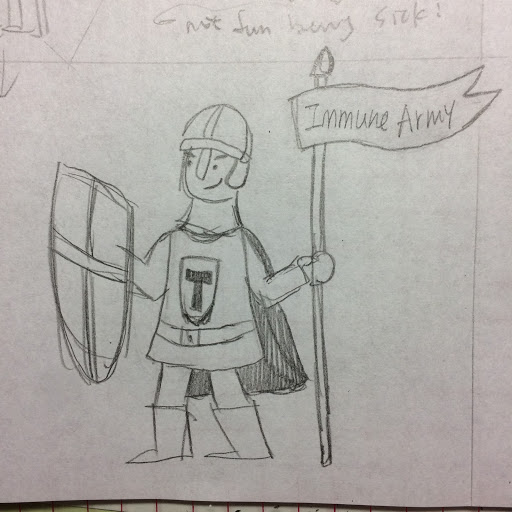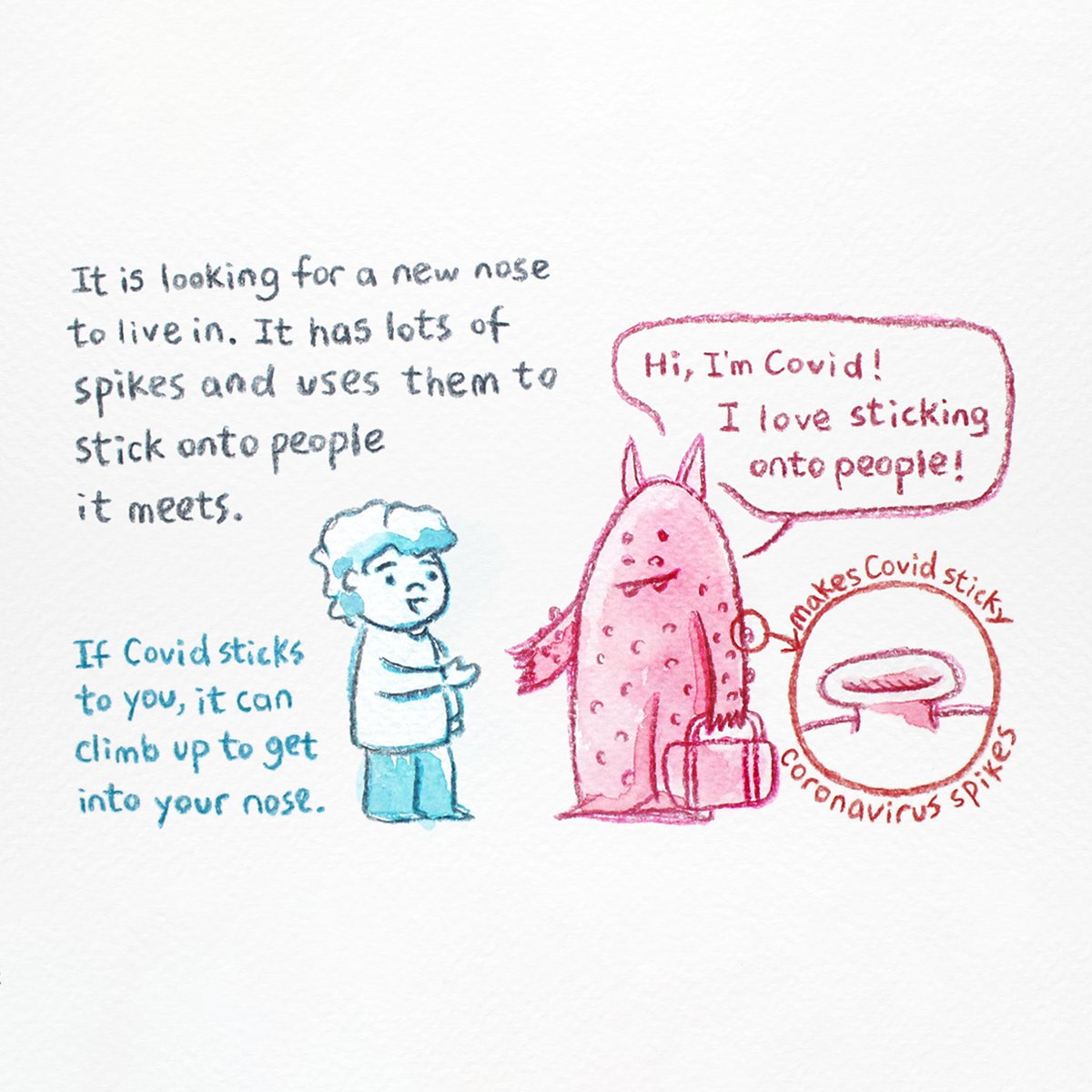In this blog post, Dr. Signe Aasberg answers your questions about the science behind Lifeology’s “Covid” visual story for kids. Why does the coronavirus like to get “on our backs”? Why do our guard cells not like viruses? Why does Covid make us sick? Why can’t we go to daycare?

Signe’s daughter reviewing the “Covid” visual story for kids.
Learn more about the science behind “How to keep Covid away!” to help you better talk to young ones about this virus.
In a short time, COVID-19 has had a massive impact on our daily lives. Suddenly schools and daycare centers are closed and many of us have to juggle home-schooling and working from home at the same time.
But how do we talk with our kids about what is going on without scaring them?
Viruses are everywhere. They are on every surface, in the soil, on your cat and on your skin. There are even the remains of viruses (like fingerprints from past infections) in our own genetic material, in our DNA. Many of the viruses around us are not harmful to humans, but a lot of them are. Famous dangerous viruses are Ebola, the Swine flu and the common cold. And recently, the 2019 novel coronavirus, the cause of a global pandemic.
Does “Covid” really like to stick to people? And can it really climb up your back and into your nose?
The 2019 novel coronavirus is covered by a spiky coat. The spikes are made up from proteins called spike proteins (so clever!) You can think of these spikes on the surface of the virus as keys. These keys allow the coronavirus to enter inside the living cells of our body. On our cells’ surface there are other proteins – the locks to the cellular contents inside, which include our DNA. When “Covid” meets a cell with the right protein-lock (called ACE2), it can attach to that cell and enter it. Once inside, the coronavirus takes advantage of YOUR cells’ machinery for making more DNA, RNA (genetic material) and proteins to make more of itself.
This is too complicated for a small child to understand. But the concept of sticking on to you to get to a party going in your nose (and to make new virus friends) is understandable.
So no, the coronavirus can’t “climb” in the sense that we know it. But it can land on (through others’ coughs and sneezes) or “hitch a ride” to (via your hands) the living cells of your body, particularly cells in and near your nose, mouth and eyes. From there, the virus particles find and enter cells in your upper and lower respiratory tracts – cells in your nose, your throat, your lungs. The virus may also infect cells in your gut.
“How to keep Covid away!” visual story panel
Why do viruses want to be inside us? Why does Covid make us sick?
Viruses are not exactly alive. They are genetic material encapsulated or wrapped up into a tiny package by a few proteins (and fat, in some cases). The genetic material has only one objective; to make more of itself. In order to do so, it must enter a living cell and use that cell as a machine to make more virus. When this happens, we get symptoms of disease. We also get symptoms when our immune system fights the virus.
Why do guard cells not like viruses?
My daughter has repeatedly asked me why the guard cells want to kick out the virus. I have told her they do it because the virus makes us sick and the guard cells want to keep us healthy.
In the course, we called them guard cells, but of course we meant the immune system. You will notice the “T” on the guard’s chest plate in our Covid visual story! T cells are a type of immune cell that are important to stop viral infections, but other cells in the immune system are important too. A healthy immune system will use a strictly regulated response to remove the virus. This immune response involves several cell types and signaling molecules called cytokines. Unfortunately for us, however, cytokines can cause lots of inflammation in the process of carrying messages between our immune cells.

A sketch of the immune cell, by Elfy Chiang.
Guards that need help
Some people get severely sick from Covid-19. To a large extent, these are people who are aged 65 years and older, and/or who have underlying chronic conditions or “risk factors” including diabetes, serious heart conditions, lung disease or moderate to severe asthma. Younger people might also get severely sick from Covid-19, and currently we don’t always know why this is the case. People who are immunocompromised (who don’t have fully functional immune systems or who are taking medications that suppress their immune systems), including people going through cancer treatment are at increased risk of getting severely sick. People with severe obesity might also be at risk. (Source: CDC.)
In our COVID visual story for kids, we didn’t want to talk about severely ill patients or why some people die. However, thousands of children are currently mourning the loss of a loved one due to Covid-19. If you as a parent or caretaker find yourself in this situation, you might use the idea of guard cells that need help to talk to your child about why a loved one had to be admitted to hospital.
A few words about fever
The temperature in your body is carfully regulated by specialized brain cells, called thermoregulatory neurons. When you get sick, your immune cells signal to these neurons that they are fighting an intruder. In response, the neurons tell the body to produce more heat. Your body can do this by increasing your metabolism. At the same time, small blood vessels are told to constrict, to prevent losing heat.
The increased temperature in your body makes your immune cells more effective. At the same time, some bacteria or viruses can’t tolerate the increased heat. At the moment, we do not fully know the effect of fever directly on COVID-19, but we do know that it helps the immune system fight the infection.
Picking nose and washing hands
In our story, children are encouraged not to pick their nose because they might put the virus up their nose!
You see, the coronavirus can’t enter your body through the skin of your hands, as long as your skin does not have any open wounds or cuts. Your hands are actually covered with dead skin cells that the virus can’t infect! These dead skin cells are your first line of defense against contracting infections. But virus particles can get ONTO your hands when you touch surfaces in public spaces. These virus particles have landed there from people coughing and sneezing, for example.
The problem occurs when your hands are dirty, meaning they could have virus particles on them, and then you touch your nose OR your eyes or mouth. Your eyes, nose and mouth are portals into your body for viruses and bacteria. These sites contain living cells which viruses can use to gain entry into your body.
We focused on the nose in our story as the coronavirus’ “door” to the body because children are often messing with their noses. They also don’t use tissues to do this or wash their hands before or after doing so as often as an adult would think to do.
This is why teaching kids how to properly wash their hands – and practicing it with them! – is so important.
Why is daycare or school closed? Why can’t I play with my friends?
“Mom?”
“Yes?”
“I miss daycare.”
Being able to properly answer these questions was one of the reasons we made this course. You will have heard it described as “social distancing” or “flattening the curve”. But why?
If we limit social contact now, we protect people that are at high risk of serious complications or death. But we also protect the health system. We want everyone who will get Covid to do so over a long time, as opposed to over a short period, even months. That way, fewer people will need to be admitted to hospital at once. This protects the healthcare system from “collapse” or a state of not being able to provide care to people who need it, resulting in more deaths that could have been prevented.
Several people have asked me why the story ends with two kids playing together. At this point, different countries are in different stages of the pandemic and with different regulations. In Italy, people are not allowed to go outside, while in Norway you are allowed to meet family and play with a few friends at a time.
Check your local government or health department website for more information about what social distancing or “stay at home” recommendations are in place for where you live.






